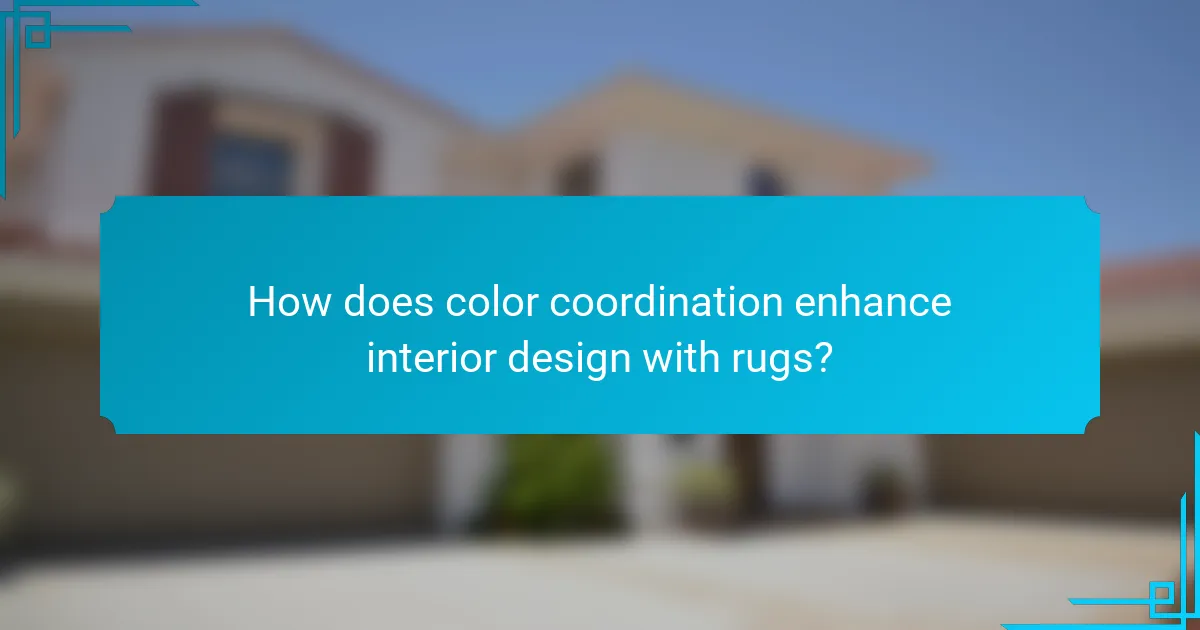Rugs are essential elements in interior design, significantly influencing aesthetics and functionality. They define spaces, add warmth, and enhance visual appeal through texture and color. The article examines how color coordination with rugs can create harmony and emotional responses in a room, while also discussing the importance of selecting appropriate sizes and materials for effective integration. Additionally, it highlights the impact of rugs on acoustics and interaction within spaces, providing guidelines for their placement to optimize comfort and design coherence.

What is the role of rugs in interior design?
Rugs play a crucial role in interior design by enhancing aesthetics and functionality. They define spaces within a room, creating zones for different activities. Rugs add warmth and comfort, making areas feel inviting. They also contribute texture and color, enriching the visual appeal of a space. Additionally, rugs can absorb sound, improving acoustics in larger rooms. According to a study by the Journal of Interior Design, rugs significantly impact the perception of space and comfort. Their placement can influence how people interact within a room, thereby enhancing the overall design.
How do rugs influence the overall aesthetic of a space?
Rugs significantly influence the overall aesthetic of a space by adding texture, color, and warmth. They serve as focal points, anchoring furniture and defining areas within a room. Different rug styles can evoke various moods, from cozy and inviting to modern and sleek. The size of a rug can alter the perception of space; larger rugs often make rooms feel more expansive. Color coordination between rugs and existing decor enhances visual harmony. Patterns on rugs can introduce dynamic elements to a design, creating interest and depth. According to a study by the American Society of Interior Designers, rugs contribute to the overall comfort and style of a space, impacting how individuals feel within it.
What are the different styles of rugs and their impacts on design?
Different styles of rugs include traditional, contemporary, Persian, shag, and flatweave. Each style impacts interior design by influencing the overall aesthetic and mood of a space. Traditional rugs often feature intricate patterns and rich colors. They evoke a sense of history and elegance. Contemporary rugs typically have minimalist designs that promote a modern feel. Persian rugs are known for their craftsmanship and can serve as focal points in a room. Shag rugs add texture and warmth, making spaces feel cozy. Flatweave rugs are versatile and easy to maintain, suitable for high-traffic areas. The choice of rug style can enhance color coordination and texture in a room, affecting the visual balance and harmony of the design.
How do rugs contribute to the ambiance of a room?
Rugs enhance the ambiance of a room by adding warmth and texture. They create a visual focal point that anchors furniture arrangements. Rugs also influence the color scheme, harmonizing or contrasting with existing decor. Their size affects spatial perception, making rooms feel cozier or more expansive. Additionally, rugs absorb sound, reducing noise and creating a more serene environment. The material and design of a rug can evoke different moods, from casual to formal. Overall, rugs play a crucial role in defining a room’s character and comfort.
Why is texture important in rug selection?
Texture is important in rug selection because it influences both aesthetics and functionality. The texture of a rug can affect the overall visual appeal of a room. For instance, a plush rug adds warmth and comfort, while a flat-weave rug offers a sleek, modern look. Additionally, texture impacts the tactile experience underfoot. A softer texture can enhance comfort in living spaces, while a more durable texture may be preferred in high-traffic areas.
The right texture can also help define a space. A shaggy rug can create a cozy atmosphere, while a jute rug can add a natural, rustic touch. Furthermore, texture can interact with light, changing the perception of color and depth in a room. According to a study by the American Society of Interior Designers, texture is a key factor in creating balanced and harmonious interiors. This demonstrates that texture plays a critical role in both design and user experience.
What types of textures are commonly found in rugs?
Common textures found in rugs include plush, flatweave, shag, and looped. Plush rugs feature a soft, dense pile that provides comfort. Flatweave rugs have a smooth, flat surface, making them easy to clean. Shag rugs are characterized by long, thick fibers that create a cozy feel. Looped rugs consist of loops of yarn, offering durability and a textured appearance. Each texture serves different aesthetic and functional purposes in interior design.
How does texture affect the feel and look of a room?
Texture significantly influences the feel and look of a room. It adds depth and visual interest to spaces. Different textures can evoke various emotions and atmospheres. For instance, soft textures like plush rugs create warmth and comfort. Conversely, sleek surfaces can impart a modern, minimalist aesthetic.
Incorporating varied textures contributes to a layered design. This layering enhances the overall sensory experience of a room. Research indicates that texture affects perception; tactile elements can influence mood and comfort levels. A study by the Journal of Interior Design found that rooms with diverse textures are perceived as more inviting.
Thus, texture is a crucial element in interior design that shapes both the aesthetic and emotional responses to a space.
What considerations are there for rug size in interior design?
Rug size in interior design is crucial for creating balance and functionality in a space. The dimensions of a rug should complement the furniture arrangement. Ideally, the rug should be large enough to accommodate all key furniture pieces. This often means placing the front legs of sofas and chairs on the rug.
Room size also influences rug selection. In smaller rooms, a larger rug can create an illusion of space. Conversely, in expansive areas, multiple smaller rugs can define different zones.
Traffic patterns are another consideration. High-traffic areas may require smaller, more durable rugs to withstand wear. Additionally, the rug’s shape should suit the room layout, whether rectangular, round, or square.
Finally, the rug’s size should align with the desired aesthetic. A well-chosen size enhances the overall design, contributing to harmony and visual interest.
How do you determine the appropriate rug size for a space?
To determine the appropriate rug size for a space, measure the area where the rug will be placed. Consider the furniture layout and how much of it should sit on the rug. A common guideline is to have the front legs of furniture on the rug. This creates a cohesive look. For dining rooms, the rug should extend beyond the table and chairs when pulled out. In bedrooms, a larger rug can frame the bed. Additionally, the size of the room influences the rug dimensions. A small rug in a large room can feel out of place, while a large rug can unify the space.
What are the common mistakes made when selecting rug sizes?
Common mistakes made when selecting rug sizes include choosing a rug that is too small for the space. A small rug can make a room feel disjointed. Many people fail to consider furniture placement. Rugs should ideally anchor furniture arrangements. Another mistake is not measuring the area accurately. Incorrect measurements can lead to ill-fitting rugs. Additionally, some overlook the scale of the room. A large room requires a larger rug for balance. Lastly, people often ignore the rug’s purpose. Different areas have different needs, like high traffic versus decorative spaces. These mistakes can significantly impact the overall design and functionality of a room.

How does color coordination enhance interior design with rugs?
Color coordination enhances interior design with rugs by creating harmony and visual interest in a space. When rugs complement the color palette of a room, they unify various design elements. This unification can make a space feel cohesive and well-designed. For instance, a rug that incorporates colors from the walls or furniture can draw the eye and create a focal point. Additionally, color-coordinated rugs can influence the mood of a room. Warm colors can evoke feelings of comfort, while cool colors can promote relaxation. Studies show that color choices can significantly impact emotional responses in interior spaces. Therefore, selecting rugs that align with the overall color scheme can enhance the aesthetic appeal and function of a room.
What are the principles of color theory in relation to rugs?
Color theory principles in relation to rugs involve understanding color harmony, contrast, and emotional impact. Color harmony refers to the pleasing arrangement of colors. This can be achieved through complementary, analogous, or triadic color schemes. Complementary colors are opposite on the color wheel and create vibrant contrasts. Analogous colors are next to each other and provide a serene look.
Contrast in rugs can highlight specific areas in a room. High contrast can draw attention, while low contrast creates a more subtle effect. Emotional impact is significant in color choice. Warm colors like reds and yellows evoke energy, while cool colors like blues and greens promote calmness.
Research shows that color influences mood and perception. A study by the Institute for Color Research found that color affects decision-making and can evoke specific feelings. Therefore, selecting rug colors thoughtfully can enhance interior design.
How can contrasting colors be effectively used with rugs?
Contrasting colors can be effectively used with rugs to create visual interest and define spaces. Using a bold rug with contrasting colors can draw attention to a specific area within a room. For example, a bright red rug can stand out against neutral-toned furniture. This approach enhances the overall aesthetic and can serve as a focal point.
Additionally, contrasting colors can help balance a room’s design. A rug with a mix of dark and light colors can add depth and dimension to the space. It can also complement other decor elements, such as wall art or cushions.
Research shows that color contrast can influence mood and perception in interior design. According to a study published in the Journal of Interior Design, contrasting colors can evoke feelings of energy and excitement. This makes rugs a powerful tool in setting the desired atmosphere in a room.
What role do neutral colors play in rug selection?
Neutral colors in rug selection provide versatility and balance in interior design. They complement various color schemes and styles. Neutral rugs can enhance the overall aesthetic without overwhelming the space. They create a calming backdrop, allowing other design elements to stand out. According to design experts, neutral tones like beige, gray, and white are timeless choices. These colors adapt easily to changing decor trends. Additionally, neutral rugs can make spaces appear larger and more open. Their ability to blend seamlessly with furniture and walls is a significant advantage in rug selection.
How can rugs be used to create focal points in a room?
Rugs can be used to create focal points in a room by strategically placing them in key areas. They can define spaces, such as seating or dining areas, drawing attention to those sections. A bold color or intricate pattern can enhance a rug’s visual impact, making it a centerpiece. Additionally, the size of the rug can influence its prominence; larger rugs tend to anchor a room more effectively. According to interior design principles, contrasting a rug with surrounding decor can further emphasize its role. For instance, a bright rug in a neutral room can stand out significantly.
What techniques can be used to highlight a rug’s color?
To highlight a rug’s color, use contrasting decor elements. Placing a rug against a complementary wall color enhances its visibility. Use furniture in neutral tones to allow the rug’s colors to stand out. Incorporate lighting techniques, such as spotlights, to draw attention to the rug. Layering rugs can also create depth and highlight color variations. Additionally, using accessories that echo the rug’s colors can create a cohesive look. These techniques effectively emphasize the rug’s hue and enhance the overall interior design.
How does the color of a rug affect the perception of space?
The color of a rug significantly influences the perception of space. Lighter colors tend to make a room feel larger and more open. Darker colors can create a cozier, more intimate atmosphere. Bright colors can energize a space and draw attention, while muted tones promote calmness. According to a study published in the Journal of Environmental Psychology, color can alter spatial perception, affecting how individuals experience the dimensions of a room. The study highlights that color impacts mood and perception, reinforcing the idea that rug color plays a crucial role in interior design.

What are the practical tips for integrating rugs into interior design?
To integrate rugs into interior design effectively, select a rug size that complements the room’s layout. A common guideline is to ensure that the front legs of furniture sit on the rug. This creates a cohesive look. Choose colors and patterns that enhance the existing color scheme. Neutral rugs can unify diverse decor styles. Textured rugs add depth and interest to spaces. Layering rugs can also create a unique aesthetic. Consider the rug’s material for durability and maintenance. Finally, ensure the rug is placed in a location that encourages comfort and functionality.
How can you effectively layer rugs for added texture?
To effectively layer rugs for added texture, start with a large, neutral base rug. This creates a solid foundation. Next, choose a smaller, patterned rug to place on top. The contrasting designs enhance visual interest. Ensure the rugs have different textures, such as a plush rug over a flat weave. This adds depth to the space. Use rugs of varying shapes to break monotony. For example, mix rectangular and round shapes. Position the smaller rug off-center to create a casual look. Layering rugs can also define areas in open spaces. This technique is widely used in interior design to create warmth and complexity.
What are the best practices for maintaining rug appearance?
Regular vacuuming is essential for maintaining rug appearance. It removes dirt and debris that can wear down fibers. Vacuum at least once a week, more frequently in high-traffic areas. Spot clean spills immediately to prevent stains from setting. Use a clean cloth with mild detergent and water for this purpose. Rotate rugs every six months to ensure even wear. This practice helps maintain color consistency across the surface. Professional deep cleaning is recommended every 1-2 years. This can extend the life of the rug significantly. Avoid direct sunlight to prevent fading. Use curtains or blinds to protect rugs from UV rays. Following these practices can keep rugs looking vibrant and fresh.
What common challenges arise when using rugs in design?
Common challenges when using rugs in design include sizing issues, color coordination, and maintenance. Sizing problems arise when rugs are either too small or too large for a space. A rug that is too small can make a room feel disjointed. Conversely, an oversized rug can overwhelm a space. Color coordination challenges occur when the rug does not match or complement existing decor. This can lead to a clash of styles and disrupt the visual flow. Maintenance is another significant concern. Rugs can accumulate dirt and require regular cleaning. Certain materials may be more difficult to clean than others, impacting longevity and appearance. These challenges can affect the overall aesthetic and functionality of a space.
How can you troubleshoot issues with rug placement and design?
To troubleshoot issues with rug placement and design, first assess the size of the rug. A rug should fit the scale of the room. Ensure that furniture is appropriately placed on or around the rug. This creates a cohesive look. Next, evaluate the color and pattern of the rug. It should complement the overall color scheme of the room. If the rug clashes, consider swapping it for a more harmonious option. Check the texture of the rug as well. It should align with the desired ambiance of the space. A soft rug suits cozy areas, while a sleek design works for modern spaces. Finally, consider the layout of the room. The rug should enhance the flow and functionality of the space. Adjusting the placement can often resolve design conflicts.
What are the latest trends in rug design and placement?
The latest trends in rug design include bold patterns, natural materials, and layered placements. Geometric and abstract designs are gaining popularity, reflecting modern aesthetics. Natural fibers like jute and wool are favored for their sustainability and texture. Layering rugs is a common practice, adding depth and interest to spaces. Large area rugs are being used to define zones in open floor plans. In terms of color, earthy tones and muted palettes are trending, promoting a calming atmosphere. Vintage and antique rugs are also making a comeback, adding character to contemporary interiors. These trends reflect a growing emphasis on personalization and comfort in home design.
The main entity of this article is rugs and their significant role in interior design. The article explores how rugs enhance aesthetics, define spaces, and contribute to comfort and acoustics in a room. It discusses the influence of different rug styles, textures, and sizes on overall design, as well as the importance of color coordination in creating visual harmony. Additionally, practical tips for integrating rugs into design, common challenges, and current trends in rug design and placement are addressed to provide a comprehensive understanding of their impact on interior spaces.